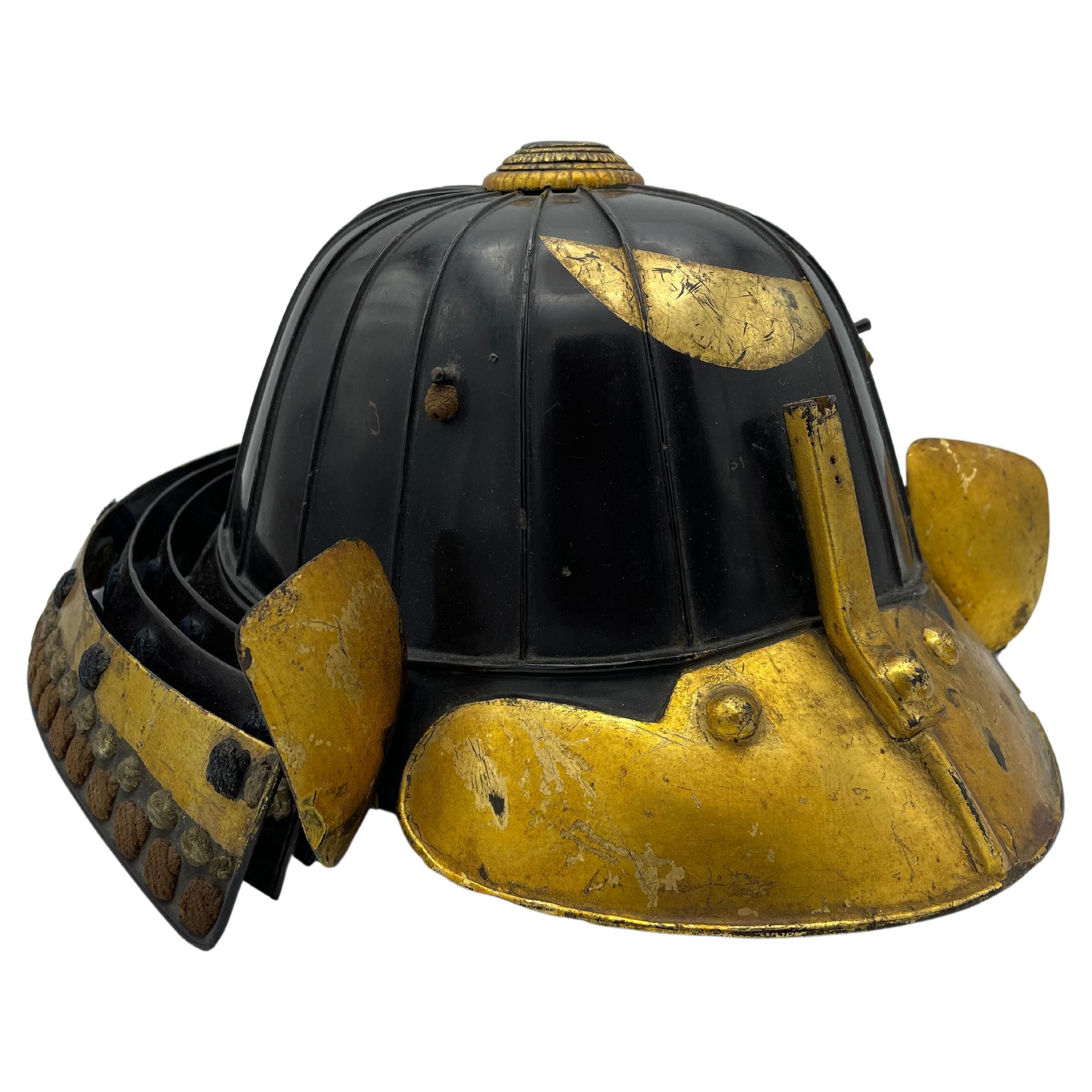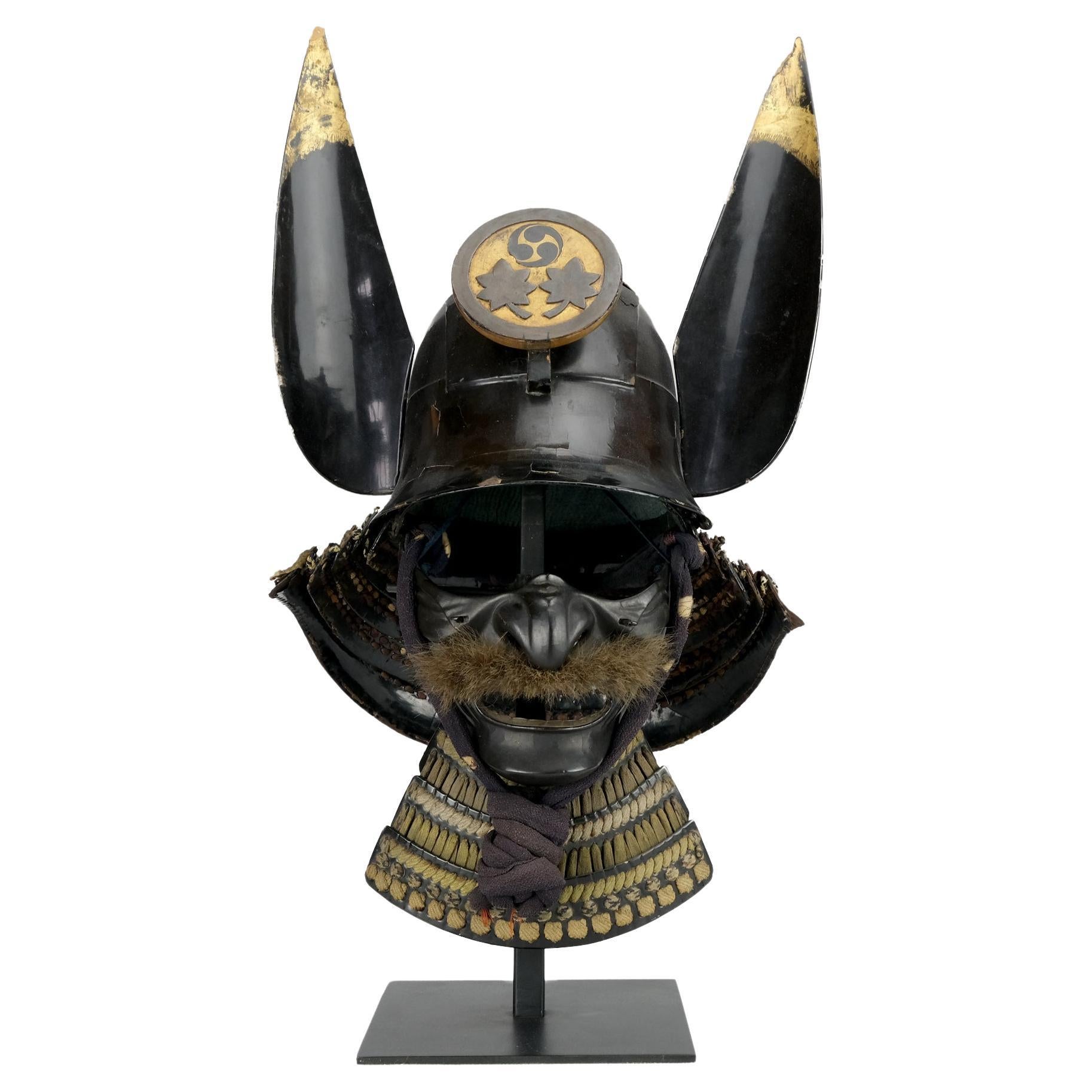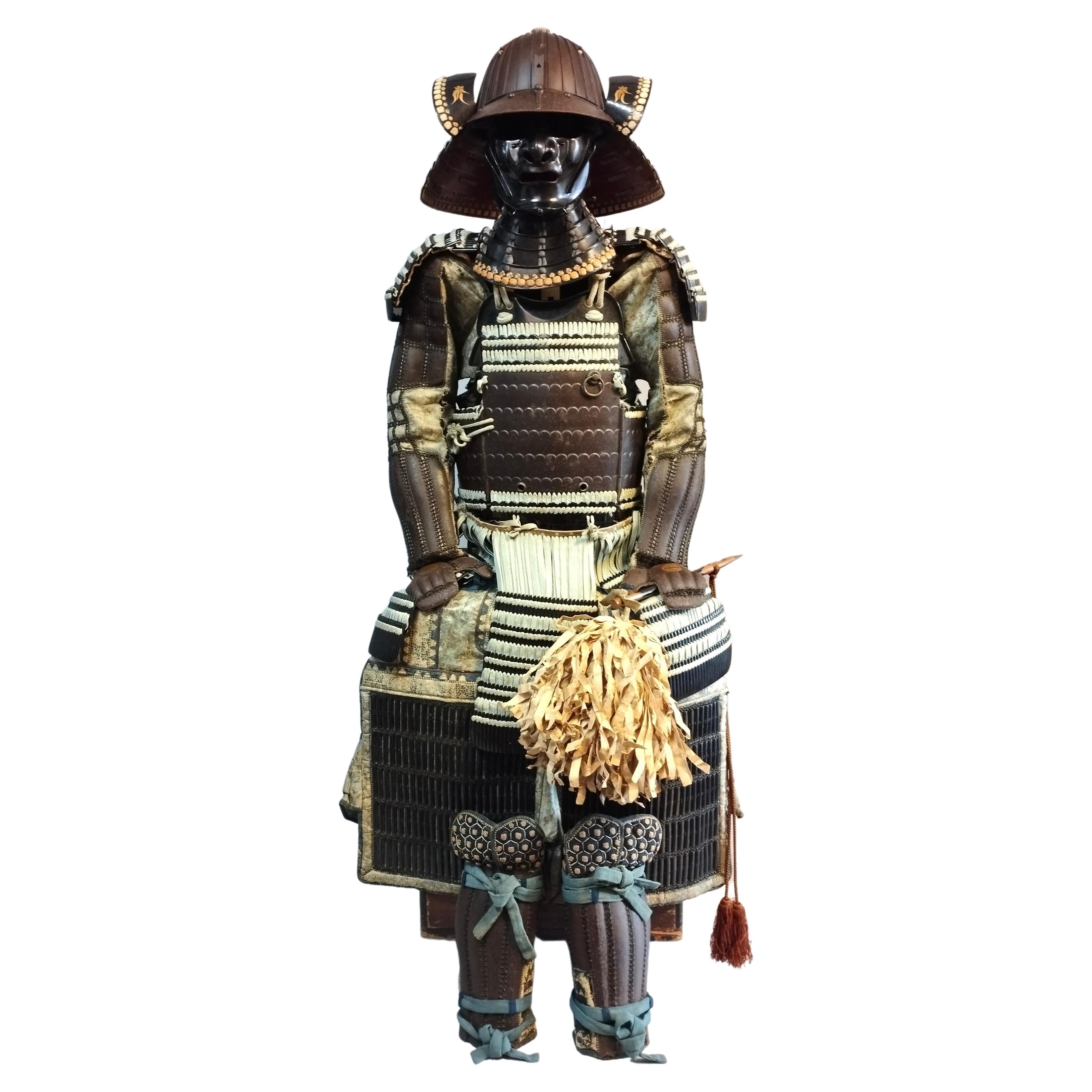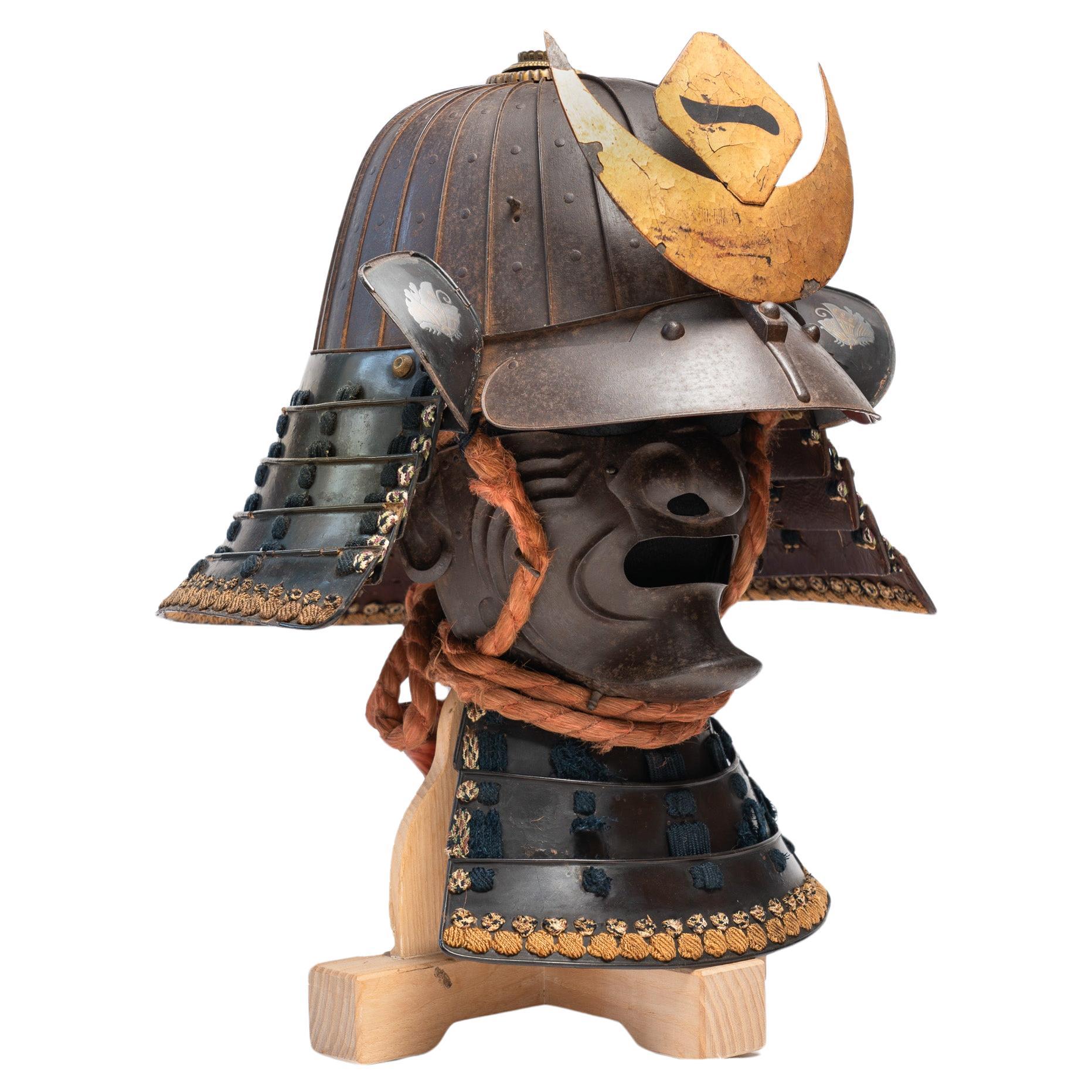Items Similar to Signed Japanese Edo suji’bachi kabuto (helmet) with a moon & cloud maedate
Want more images or videos?
Request additional images or videos from the seller
1 of 19
Signed Japanese Edo suji’bachi kabuto (helmet) with a moon & cloud maedate
About the Item
An antique, outstanding signed suji’bachi kabuto (helmet with ridges) surmounted by a gilt metal maedate (forecrest) shaped like a full moon emerging from the clouds heightened by a circular applique depicting three swirling commas (mitsudomoe).
The 52-plate ‘russet iron’ bowl of the the kôseizan type (tall shape). On top a high bronze 7-tiered tehen’no’kanamono (decorative apex fitting). The visor (mabizashi) covered by light decorative ‘smoked leather’ and flanked by a pair of very small fukigaeshi (face guards) finished with black lacquer.
The long, curved four-lame ‘kiritsuke kozane’-plate shikoro (neck guard) lacquered black as well and laced with navy blue silk cords.
The inside of the bowl with an attribution to ‘Munetake’. Signed ‘Made by Munetake’ (Munetake saku).
Period: Japan - Late Edo Period (First half 19th century). The shikoro are a marriage to the bowl, both being of the same period.
Approx. Size:
Height 12.20 in/31 cm, Width 11.81 in/30 cm, Depth 13.77 in/35 cm.
Length maedate 3.93 in/10 cm.
Weight 5.07 lbs/2.3 kg.
When shipped we will add a certificate of authenticity.
Price including insured shipping.
- Dimensions:Height: 12.21 in (31 cm)Width: 11.82 in (30 cm)Depth: 13.78 in (35 cm)
- Materials and Techniques:
- Place of Origin:
- Period:
- Date of Manufacture:Late Edo period (First half 19th century)
- Condition:Wear consistent with age and use. Minor losses. Seen its age, approx. 170-220 years old, it is in a very good condition with traces of wear consistent with age, like minimal lacquer loss along the rims and some wear of the lining. Please look at the photos for a condition reference.
- Seller Location:Amsterdam, NL
- Reference Number:
About the Seller
5.0
Vetted Seller
These experienced sellers undergo a comprehensive evaluation by our team of in-house experts.
Established in 1996
1stDibs seller since 2022
16 sales on 1stDibs
Typical response time: 10 hours
- ShippingRetrieving quote...Ships From: Zwanenburg, Netherlands
- Return PolicyA return for this item may be initiated within 14 days of delivery.
More From This SellerView All
- Japanese Edo-period gosho’ningyô 御所人形 (palace doll) of plump, seated childLocated in Amsterdam, NLA charming gosho’ningyô (palace doll) of plump, seated child with a brilliant white skin and a small delicately elegant face, reminiscent of a young noble. The doll is playfully rais...Category
Antique Early 19th Century Japanese Antiquities
MaterialsPaste, Silk, Paint
- Pair of Japanese High Quality Chôshi 銚子 'Sake Ewers', Signed 'Sei’ô' 晴王Located in Amsterdam, NLPair of high quality cast iron chôshi (sake ewers) with a detailed lacquered lid. Its body with a refined embossed design of a bird of prey (môchô) perched o...Category
Antique Late 19th Century Japanese Antiquities
MaterialsIron
- Red lacquer Festival Flag Support abundantly inlaid with mother-of-pearl, JapanLocated in Amsterdam, NLRare museum-worthy Japanese lacquered wooden festival support for a flag. In feudal Japan this kind of supports sat on the back of a horse or ox during pr...Category
Antique 19th Century Japanese Antiquities
MaterialsMetal, Bronze, Copper
- Rare set of 2 Japanese suits-of-armour, complete with 2 matching folding screensLocated in Amsterdam, NLImportant unique set of two suits-of-armour (yoroi), complete with two high six-panel screens, that belong together as is indicated by the used family crests (mon). Two crests are used, both belonging to the Nakagawa family of Oka Castle, Ôita prefecture on Kyûshû. They are: – the Nakagawa-kurusu, a circle depicting a Celtic-like cross through a ring. The cross was originally a Christian symbol but after the ban on Christianity in Japan the use of a hidden cross in family crests could continue. – the Nakagawa-kashiwa, two leaves of the Japanese Emperor Oak turned to each other (dakikashiwa mon). The remarkable aspect of this ensemble is the presence of matching crests on both the yoroi and the accompanying folding screens. The kurusu and kashiwa crests adorning the yoroi are elegantly replicated on the screens, providing compelling evidence that these pieces form a harmonious and unified set. This exceptional cohesion between the armour and screens further enhances their artistic and historical value. After the warlord Toyotomi Hideyoshi (1537-1598) had interfered in the battle between the Lord of Bungo Province Ôtomo Yoshi-mune (1558-1605) and the Shimazu of Hyûga Province, he split the Bungo Province in a number of small fiefs and transferred in 1594 Nakagawa Hideshige (1570-1612) from Miki Castle in the Harima Fief to Oka Castle in Kyûshû. The Nakagawa family stayed in possession of Oka Castle till the abolishment of the military use of castles in 1873. In 1884 the Nakagawa family received the title of Count (a title in use till the abolishment of aristocracy in 1947). After the Nakagawa’s left, the castle and the building soon dilapidated and is now known as Oka Castle Ruins. The castle is located in Taketa Village part of Taketa Town in Ôita Province on Kyûshû. > Set of two tall byôbu (folding screens), painted with large red jinmaku (camp enclosure curtain) on a gold leaf ground. The curtains show both crests of the Nakagawa family: one screen depicts two Nakagawa-kurusu crests next to a Nakagawa-kashi crest in the middle, and the other shows the symbols the other way round. Dimensions: Total width 148.66 in/377.6 cm (2 x 25.35 in/64.4 cm, 4 x 24.48 in/62.2 cm); Height 72.63 in/184.5 cm. Period: Japan – Late Edo period (First half 19th century), and maybe even older. > Yoroi with Nakagawa-kashiwa crest: A Japanese black lacquered suit-of-armour (yoroi) completely laced with orange cords (kuro’urushinuri hi’ito odoshi nimai’dô’maru). A thirty-two plate suji’bachi kabuto (helmet with raised ridges) with in front a maedate (fore crest) -with traces of gilding- in the shape of flames, resembling a mythical flaming bird flying down. The fukikaeshi (face guards) and the mabizashi (visor) have the Nakagawa-kashiwa crest in gold maki-e lacquer. Five curved ‘itazane’-plate neck guards (shikoro) laced with orange cords. Together with an ‘angry man...Category
Antique 18th Century Japanese Antiquities
MaterialsGold Leaf, Iron, Metal
- Pair of Japanese Carved Wooden Temple Ornaments 木鼻 'Kibana' Shaped like Baku 獏Located in Amsterdam, NLA lovely pair of very detailed carved wooden temple ornaments (kibana) in the shape of elephant-like mythical creatures known as ‘Baku’. Baku are Japan...Category
Antique Early 19th Century Japanese Sculptures and Carvings
MaterialsWood
- Rare Ainu Navy Cotton Robe Featuring Wide Appliquéd Geometric Bands, JapanLocated in Amsterdam, NLRare Japanese Ainu navy blue cotton robe featuring wide red and white appliquéd bands along the edges with embroidered geometric shapes. Acquired from an Ainu education center in th...Category
Early 20th Century Japanese Textiles
MaterialsCotton
You May Also Like
- Japanese Antique Combat Helmet 'Kabuto' 1800s Edo EraLocated in Paris, FRThis is an antique combat helmet made around 1800s in Edo era in Japan. Kabuto is a type of helmet first used by ancient Japanese warriors which, in later periods, became an important part of the traditional Japanese armour...Category
Antique Early 19th Century Japanese Antiquities
MaterialsIron
- Samurai Helmet "Zunari Kabuto" - Early Edo (circa 1610)Located in Paris, FRSamurai Helmet "Zunari kabuto" with 3 black lacquered iron plates. Japan, early EDO period, circa 1610. Neck protector (shikoro), 5-strip hineno, laced brown, beige and green. Centra...Category
Antique Early 17th Century Japanese Edo Antiquities
MaterialsIron
- 18th Century Hirate Clan Samurai Armor with Signed Kabuto HelmetLocated in Fukuoka, JPThis is a truly exceptional set of 18th century Samurai armor that is sure to impress any collector or enthusiast. The patinated iron used in its construction has aged beautifully, giving the armor a truly unique appearance that is sure to catch the eye. The brocade silk and cotton padding used to line the armor not only provide a comfortable fit for the wearer, but also add an extra layer of decorative flair. One of the most striking features of this armor is the crests of the Hirate samurai clan that adorn it. These crests are a symbol of the clan's identity and heritage, and their presence on the armor speaks to the deep connection between samurai warriors and the clans they belonged to. The Kabuto...Category
Antique 18th Century Japanese Antiquities
MaterialsIron
- Suji-bachi kabuto and menpo Signed by Myōchin Muneaki and dated 1853Located in Milano, ITSuji-bachi kabuto and menpo Signed by Myōchin Muneaki and dated 1853 Signature: Kaei 6 - Ushidoshi Oshu Nihonmatsu-ju Myōchin Ki (no) Muneaki saku Made in 1853 by Myōchin Ki Muneak...Category
Antique 18th Century and Earlier Metalwork
MaterialsIron
- Japanese Samurai Helmet Kabuto Edo Period (1603-1867)Located in Hampstead, QCA Japanese Samurai black-lacquered helmet (kabuto) in suji bachi style and of a goshozan shape consisting of the: - main dome (hachi) made from 16 plates in natural iron riveted to...Category
Antique Early 19th Century Japanese Edo Metalwork
MaterialsIron
- Japanese edo period shrine altarBy Vintage Japanese MonochromeLocated in CARLTON, AUElegant and sacred, rare look was its amazing wave textures. This beautiful piece with refined details shows a great stillness, which was made during edo period and executed with Jap...Category
Antique Early 17th Century Japanese Edo Antiquities
MaterialsCedar
Recently Viewed
View AllMore Ways To Browse
Yellow Jade Cong
White China Pair Dancers Figurine
Han Stick Man
Qianlong Moon Flask
Black Finish
Danish Design Modern
Eye Catching
Lamps 1950s
Beautiful Mirrors
Mirror For Hall
Vintage Chandelieres
Aluminum Glasses
Metal Stand
Wooden Back
Aesthetically Perfect
Brown Leather Mid Century
Antique French Objects
Shipping Options





